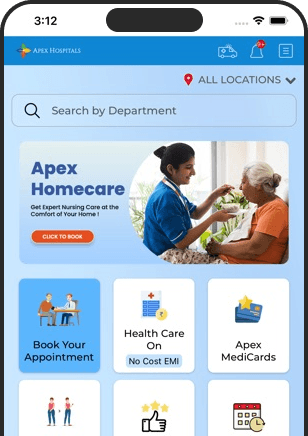
Non Alcoholic fatty liver disease
Non-Alcoholic Fatty Liver Disease (NAFLD) is one of the most common liver conditions globally, and it's growing fast in India. The Ministry of Health and Family Welfare (MoHFW), Government of India, has acknowledged the rising public health burden of Non-Alcoholic Fatty Liver Disease (NAFLD) in India. NAFLD affects an estimated 9% to 32% of the Indian population, depending on the region and risk factors like obesity, diabetes, and metabolic syndrome. According to the World Health Organisation (WHO), it affects nearly 1 in 4 people worldwide. NAFLD refers to excess fat buildup in the liver not caused by alcohol. Often silent in its early stages, it can lead to serious complications like liver inflammation, scarring (fibrosis), or even cirrhosis if left untreated.
As lifestyle diseases increase due to sedentary habits and poor diets, early awareness and proactive care are critical.
What are different types of abdominal pain?
Abdominal pain can manifest in various forms, categorized by its onset and duration:
1. Acute pain: This type of pain develops rapidly over a few hours or days and may be accompanied by additional symptoms.
2. Chronic pain: Chronic pain may exhibit intermittent episodes lasting for an extended period, from weeks to months or longer.
3. Progressive pain: This pain intensifies gradually over time and is often accompanied by other symptoms.
What causes abdominal pain?
Abdominal pain can stem from various underlying conditions, with the primary causes including:
- Infection
- Abnormal growths
- Inflammation
- Obstruction (blockage)
- Intestinal disorders
- Diseases affecting abdominal organs
Infections in the throat, intestines, or bloodstream can lead to digestive discomfort such as diarrhea or constipation.
Menstrual cramps also contribute to lower abdominal pain, typically linked to pelvic discomfort.
Common culprits include:
- Constipation
- Diarrhoea
- Gastroenteritis (stomach flu)
- Acid reflux (heartburn)
- Vomiting
- Stress
Chronic abdominal pain may be caused by:
- GERD
- IBS
- Crohn’s disease
- Lactose intolerance
Severe abdominal pain could indicate:
- Organ rupture (e.g., appendicitis)
- Gallstones
- Kidney stones
- Kidney infection
Pain localization clues:
- Generalized pain: Appendicitis, Crohn’s, trauma
- Lower abdomen: Obstruction, ectopic pregnancy
- Pelvic pain: Ovarian cysts, menstrual cramps
- Upper abdomen: Gallstones, heart attack, hepatitis
- Central abdomen: Gastroenteritis, appendicitis
- Lower left abdomen: Crohn’s, cancer, ovarian cysts
- Upper left abdomen: Enlarged spleen, fecal impaction
- Lower right abdomen: Hernia, kidney infection
- Upper right abdomen: Hepatitis, pneumonia, appendicitis
Seeking medical attention is crucial for accurate diagnosis and timely abdominal pain treatment, especially if the pain is severe or persistent.
When to see a doctor
If you're experiencing prolonged or unexplained abdominal pain, it's important to book an appointment.
Meanwhile:
- Eat small meals if indigestion is present
- Stay hydrated
- Avoid painkillers or laxatives unless prescribed
What is Non-Alcoholic Fatty Liver Disease (NAFLD)?
NAFLD refers to excess fat in the liver not caused by alcohol. It's silent early on but may lead to inflammation, fibrosis, or cirrhosis if untreated.
- Affects 9–32% of Indians
- Nearly 1 in 4 globally (WHO)
- Linked to obesity, diabetes, sedentary habits
Types of NAFLD:
- Simple fatty liver (steatosis): Fat with minimal inflammation
- Non-Alcoholic Steatohepatitis (NASH): Fat + inflammation + damage → fibrosis/cirrhosis
What are the stages of NAFLD?
1. Simple Fatty Liver (Steatosis)
- Often symptomless
2. Non-Alcoholic Steatohepatitis (NASH)
- Liver inflammation and damage
3. Fibrosis
- Scar tissue formation
4. Cirrhosis
- Irreversible liver damage and dysfunction
Causes & Risk Factors
- Obesity (belly fat)
- Type 2 diabetes
- High cholesterol/triglycerides
- Metabolic syndrome
- PCOS
- Unhealthy diet
- Sedentary lifestyle
- Genetics/family history
Even people with a normal BMI may develop NAFLD due to insulin resistance or high visceral fat.
Signs & Symptoms
- Fatigue
- Upper right abdominal pain
- Unexplained weight loss
- Weakness
- Mild jaundice
- Red palms
- Swollen abdomen
- Enlarged spleen
When to seek immediate medical help
Call your doctor immediately if you notice:
- Severe abdominal pain
- Yellowing of the skin or eyes
- Abdominal swelling
- Confusion
How is it diagnosed?
- Blood tests: Liver function, lipid profile, HbA1c
- Ultrasound or FibroScan: Detect fat/stiffness
- MRI/CT scan: Detailed imaging
- Liver biopsy (rare): Confirms severity
Treatment Options
There’s no one-size-fits-all cure, but NAFLD is reversible with:
Lifestyle changes:
- Lose 5–10% of body weight
- Eat a Mediterranean-style diet
- Exercise regularly
- Avoid sugar, fried foods, alcohol
Medications (as advised):
- Vitamin E (non-diabetics)
- Statins (cholesterol management)
- Metformin (for diabetics, limited liver benefit)
- Insulin sensitizers
Hospital Support:
- Nutrition clinics
- Lifestyle counselling
- Advanced diagnostics
- Liver specialists
Lifestyle Management Tips
- Switch to a Mediterranean diet
- Avoid sugary beverages
- Walk after meals
- Manage diabetes/cholesterol
- Sleep 7–8 hours
- Avoid unnecessary medications
Prevention Strategies
- Stay active
- Maintain healthy weight
- Eat balanced meals
- Annual health checkups if at risk
- Avoid excess red meat and alcohol
Complications if untreated
- NASH
- Fibrosis
- Cirrhosis
- Liver cancer
- Heart disease
Why choose Apex Hospital?
- Expert hepatologists & dieticians
- Round-the-clock emergency services
- NABH accreditation
- Advanced diagnostics & lifestyle support
- High NAFLD reversal success rates
Expert Guidelines
- AASLD: Lifestyle changes = first-line therapy
- Indian Fatty Liver Registry: Early intervention is key
> "NAFLD is common even in non-drinkers. It’s often reversible with lifestyle changes."
FAQS
Health In A Snap, Just One App.
KNOW MORE
